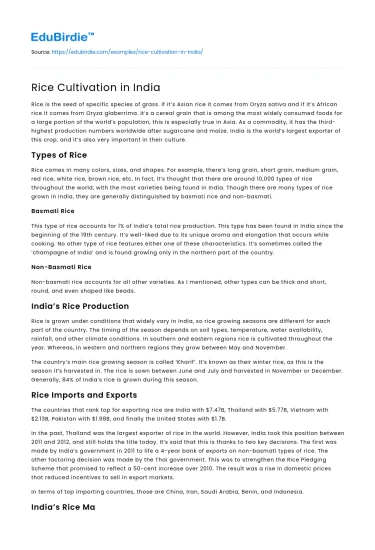Rice is the seed of specific species of grass. If it’s Asian rice it comes from Oryza sativa and if it’s African rice it comes from Oryza glaberrima. It’s a cereal grain that is among the most widely consumed foods for a large portion of the world’s population, this is especially true in Asia. As a commodity, it has the third-highest production numbers worldwide after sugarcane and maize. India is the world’s largest exporter of this crop, and it’s also very important in their culture.
Types of Rice
Rice comes in many colors, sizes, and shapes. For example, there’s long grain, short grain, medium grain, red rice, white rice, brown rice, etc. In fact, it’s thought that there are around 10,000 types of rice throughout the world, with the most varieties being found in India. Though there are many types of rice grown in India, they are generally distinguished by basmati rice and non-basmati.
Save your time!
We can take care of your essay
- Proper editing and formatting
- Free revision, title page, and bibliography
- Flexible prices and money-back guarantee
Basmati Rice
This type of rice accounts for 1% of India’s total rice production. This type has been found in India since the beginning of the 19th century. It’s well-liked due to its unique aroma and elongation that occurs while cooking. No other type of rice features either one of these characteristics. It’s sometimes called the ‘champagne of India’ and is found growing only in the northern part of the country.
Non-Basmati Rice
Non-basmati rice accounts for all other varieties. As I mentioned, other types can be thick and short, round, and even shaped like beads.
India’s Rice Production
Rice is grown under conditions that widely vary in India, so rice growing seasons are different for each part of the country. The timing of the season depends on soil types, temperature, water availability, rainfall, and other climate conditions. In southern and eastern regions rice is cultivated throughout the year. Whereas, in western and northern regions they grow between May and November.
The country’s main rice growing season is called ‘Kharif’. It’s known as their winter rice, as this is the season it’s harvested in. The rice is sown between June and July and harvested in November or December. Generally, 84% of India’s rice is grown during this season.
Rice Imports and Exports
The countries that rank top for exporting rice are India with $7.47B, Thailand with $5.77B, Vietnam with $2.13B, Pakistan with $1.98B, and finally the United States with $1.7B.
In the past, Thailand was the largest exporter of rice in the world. However, India took this position between 2011 and 2012, and still holds the title today. It’s said that this is thanks to two key decisions. The first was made by India’s government in 2011 to life a 4-year bank of exports on non-basmati types of rice. The other factoring decision was made by the Thai government. This was to strengthen the Rice Pledging Scheme that promised to reflect a 50-cent increase over 2010. The result was a rise in domestic prices that reduced incentives to sell in export markets.
In terms of top importing countries, those are China, Iran, Saudi Arabia, Benin, and Indonesia.
India’s Rice Market Outlook
Covid-19 has proven to be a disruptive force for the rice market, especially in India. Though the virus will eventually diminish, there will be some challenges to overcome. The main issue that’s affected the market has been social distancing amid the virus. India has had over 300,000 cases, and this takes a toll on migrant workers who make up most of the people who handle rice crop.
The Covid-19 situation led many workers to flee their homes, and others were left ill or scared. Yet, the good news is that though things have been uncertain up until lately, rice production is expected to reach new heights during 2020-2021. In fact, rice stocks are already beginning to build for India, Thailand, and China.
This is due largely to the fact that rice is strictly a food commodity. This is different from corn because corn can be used to feed livestock and turned into fuel. During the lockdowns imposed from the virus, many consumers were purchasing food items such as rice in large amounts because it stays good for a good length of time.
Many experts agree that as life gets back to normal after the coronavirus, the rice market will once again pick up around the world. Being such an important staple in the diets of many people around the world, rice is a commodity that’s necessary. Thankfully, lockdowns and restrictions are being lifted just as India is going into its main rice season.






 Stuck on your essay?
Stuck on your essay?

